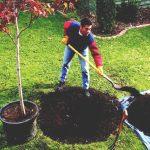Springtime is the most popular time to plant trees and shrubs, so here’s a quick guide to doing the job right:
1. Select a healthy specimen.
A single-trunk tree should have a dominant leader (tall point). Multi-trunked trees and shrubs should be vibrant and full.
2. Select the right spot.
Know the mature size of the tree or shrub you are planting, so you don’t plant a future giant (such as a Northern Red Oak that will eventually get 60 feet tall and wide) in a narrow spot between your house and the nextdoor neighbor’s.
3. Dig the right-sized hole.
Trees should be planted no deeper than the soil in which they were grown. The width of the hole should be three times the diameter of the root ball.
Use a labor-saving tool. Digging a hole with a shovel is back-breaking work. To make the job easier, use a Mantis Tiller/Cultivator to loosen the soil. Then move the tiller, shovel out the loose soil, and use the tiller to loosen some more soil. Repeat until you’ve dug the perfect-sized hole.
4. Water.
After you’ve put the root ball in the hole and backfilled with dirt, water the tree. Give it a good soaking. During the first growing season, newly planted trees and shrubs should be deeply watered once a week (in the absence of a good, soaking rain).
5. Mulch.
Cover the back-filled soil with three to four inches of mulch such as bark, wood chips or pine needles. This will conserve moisture and keep the tree from drying out. ![]()









